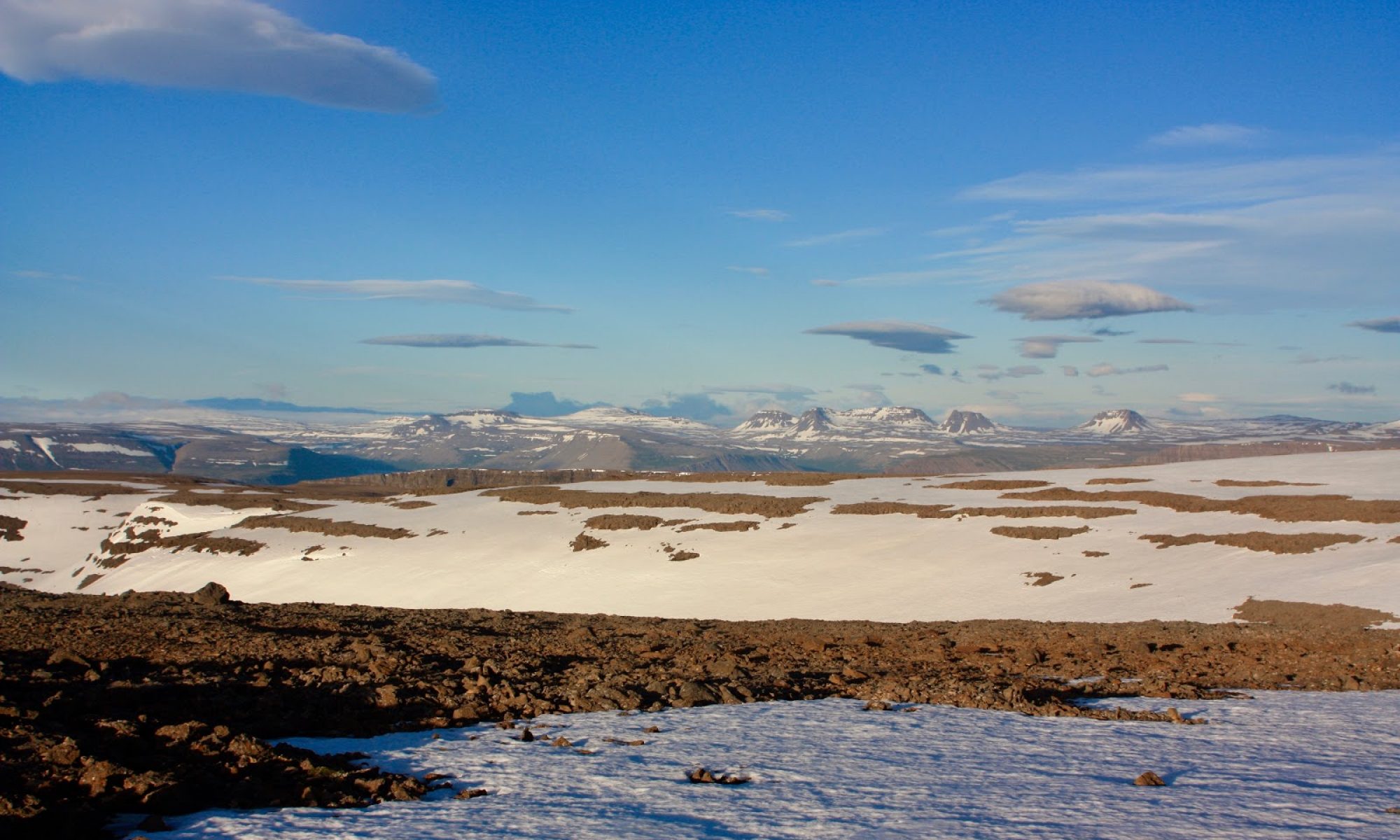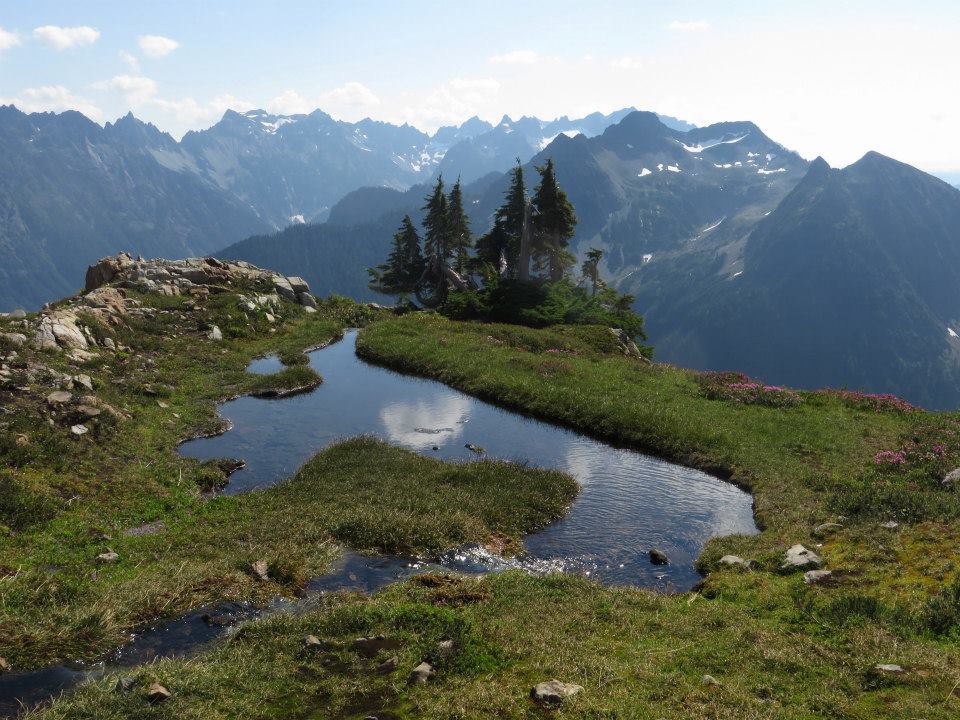
The title of this essay might lead a reader to expect a literary journey to someplace tropical, someplace in the South Pacific, someplace with coconut palms and a hammock. That might be a welcome diversion to readers who are weary of winter. Alas, this is not a journey that escapes the cold. On the contrary, it is a journey that heads straight into it. And there will be trees, but they are not palms.
This essay is indeed about atolls — but not ones formed by a coral reef. The atolls of which I speak are formed by a cluster of remarkable, resilient trees called Tsuga mertensia: the mountain hemlock. They occur not in the South Pacific, but in the Pacific Northwest, high up in the rugged, cold, and snowy North Cascade mountains of Washington state.
Like their tropical counterparts, these alpine atolls are small islands surrounded by water — only the water, in this case, is snow. And also like their tropical counterparts, they form through a process of gradual accretion, as life builds upon life.
Of course, they are not really atolls at all. It’s a metaphor, first employed by an alpine botanist in the 1930s. But it is an apt metaphor. They look like islands in the summer, when the meadows around them are a sea of wildflowers. And they look even more like islands from October to June, when they are surrounded by billowing waves of snow.
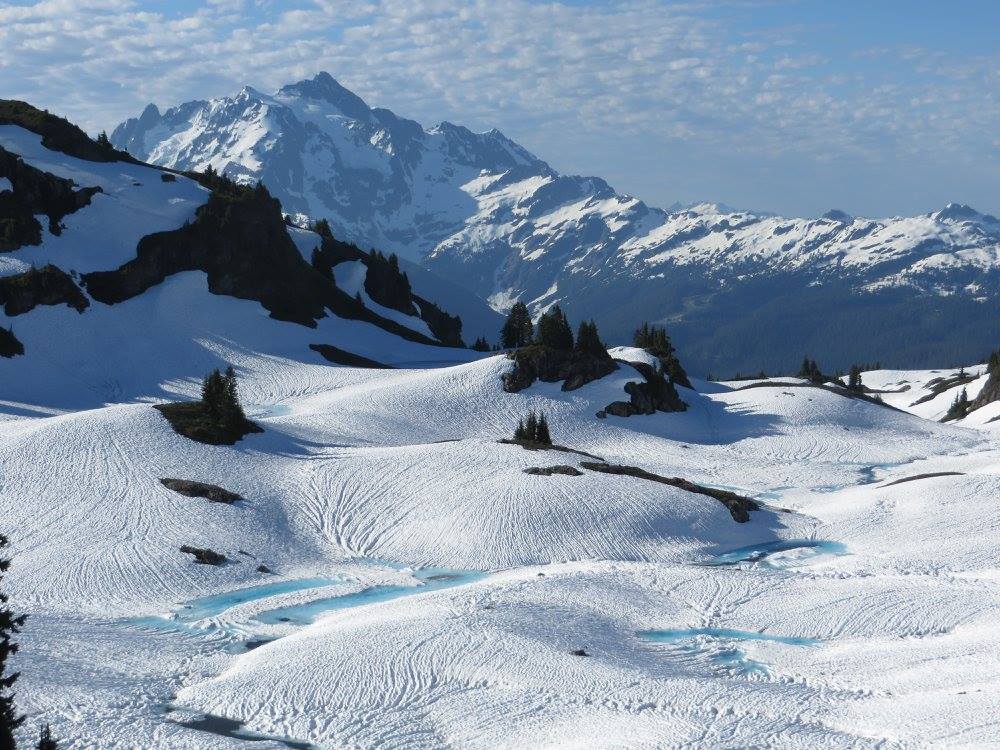
How do these atolls form? And why, among all possible distribution patterns that a tree species might adopt, does the mountain hemlock adopt this one?
The answer comes into clarity at the nexus of several key facts about climate, topography, and biology. First of all, snow is very, very deep here. The growing season is short. There are hazards to be avoided. It can be tough for any living thing to go it alone in such a place. In the subalpine zone, a seedling is more likely to survive if it is in the lee of a larger tree. Hence, the presence of one tree makes life easier for the next one, and the next one.
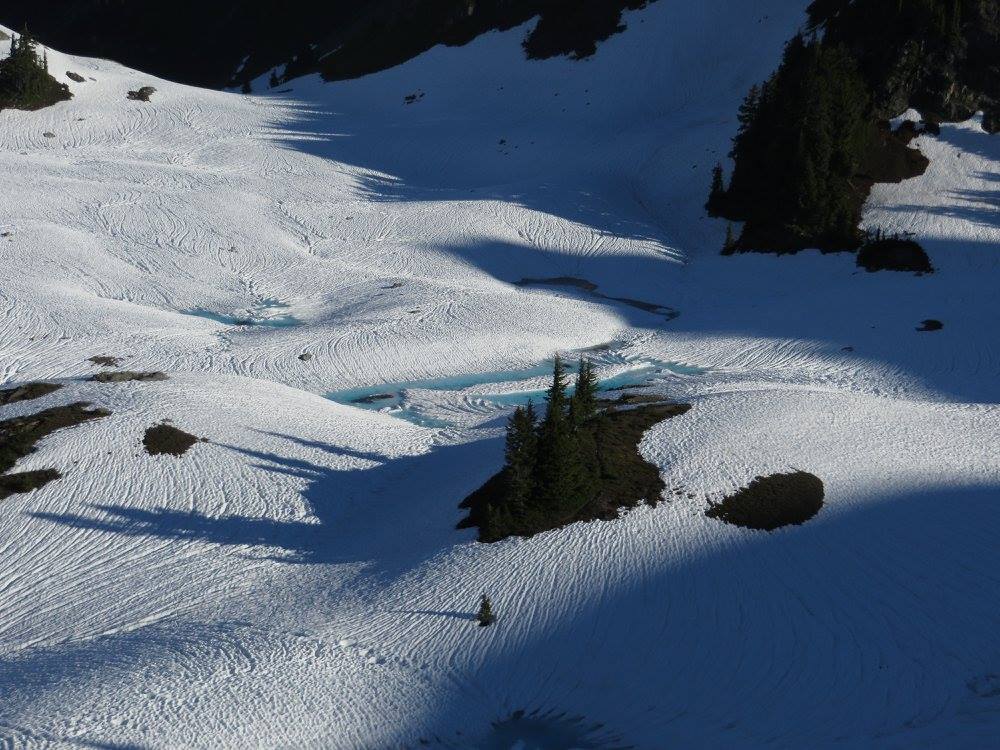
But I am getting ahead of myself. First let me introduce you to the tree itself. To my mind, the mountain hemlock captures the spirit of the North Cascades as well as any tree. If you’ve ever taken a day trip to Mount Rainier, or went skiing at the Mount Baker Ski Area, you’ve seen it. It is the snow-plastered tree that graces the January picture on a calendar.
In fall and winter, atmospheric rivers from the Pacific take aim at the Northwest coast, giving the lowland forests a long, deep drink. These forests host behemoth trees like the coast redwood, Sitka spruce, western hemlock, western red cedar, and Douglas fir. Along the rivers, big leaf maples drop their dinner-plate-sized leaves. All of these are magnificent trees. In fact, in terms of both diversity and sheer majesty, I can’t think of any place with better trees.
But where the Pacific storms bump up against the steep slopes of the North Cascades, where the wind picks up speed as it sweeps upslope, where mist wraps around ridge lines, and where the dense clouds drop heavy wet snow — tons of it — a different tree comes into its own. A tree that was built for just this climate and just this topography. It is not as big as the lowland trees, but what it lacks in size it more than makes up for in character.

It is the quintessential tree of the wet, western slope of the mountains. It is the brooding tree that so often is shrouded in mist, the one with the dark and hoary silhouette up on a ridge line. It is a dignified tree, maybe even somber. At lower elevations, mountain hemlock drapes the slopes in a dense and continuous forest. In the hours before dawn, it can be a bit spooky to hike through a forest of mountain hemlock. The word primeval comes to mind.
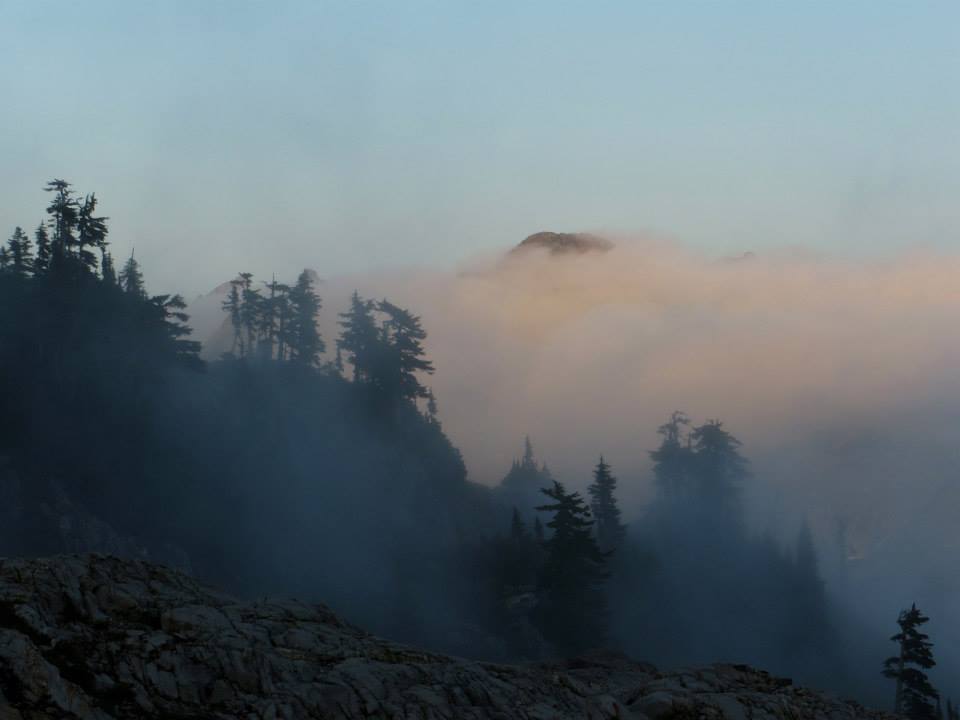
At higher elevations, it diminishes in size and grows more sparse. It often forms attractive clumps—atolls—in a meadow. One of the most distinctive features of the tree is a droopy leader at the top. It also has graceful branches that subdivide at the end into many small, supple twigs, creating a web-like bough that can hold big loads of snow (until a skier or climber happens to be directly underneath them). This leader and branches give it a distinctly different profile than the stiff and prickly spruces that occur in the subalpine zone on the dry eastern side of the Cascades.
The tree produces tons of small, narrow cones that are brown with papery scales when mature, and a beautiful luminescent shade of purple when immature. The bark is grey and shallowly furrowed. The needles are bluish-green, short, and flat, reminiscent of rosemary. They are arranged spirally around the twig, creating a ‘bottlebrush’ appearance which is accentuated in midsummer, when the growing tip erupts in bright new growth, like little stars at the end of each twig.
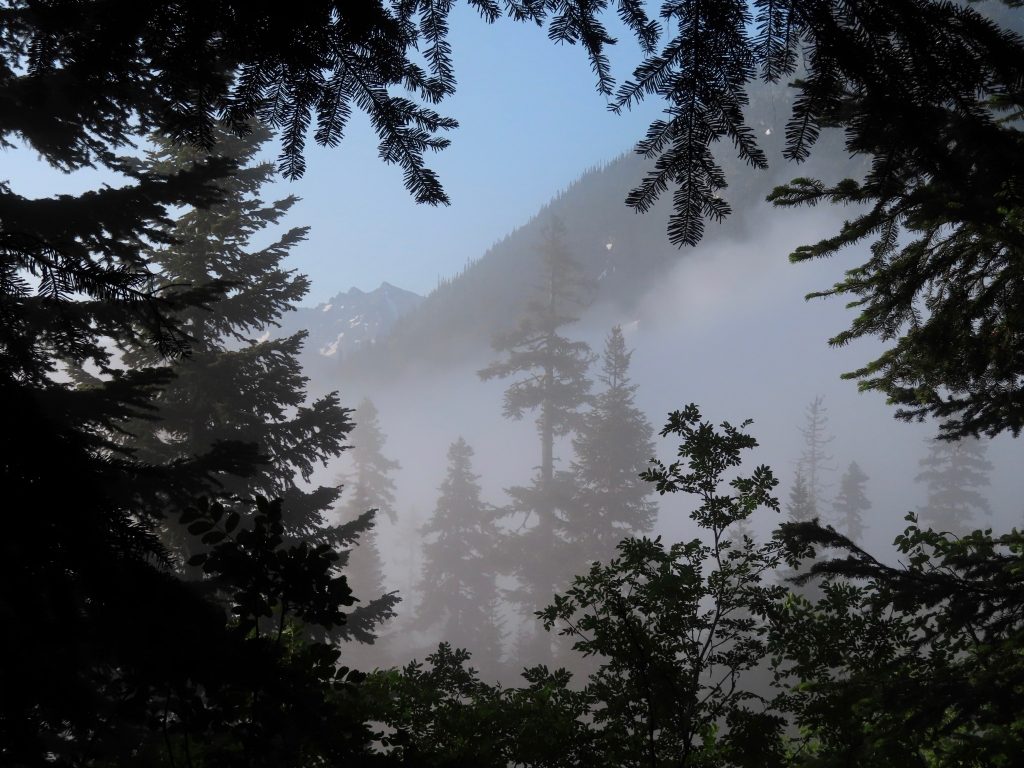
It’s clear from its name that it is not a flatlander. It inhabits coastal ranges from Southeast Alaska to California, where it is found in only the wettest parts of the Sierra Nevada. Aside from a few pockets in Northern Idaho and the northwest corner of Montana, it is not a Rocky Mountain tree. It likes things damp, shall we say. And, even though it is superbly adapted to snow, it is not a tree that wants its roots in frozen soil.
In the North Cascades it starts as low as 3000 feet, where it mixes with Pacific silver fir, and extends all the way to timberline, which is generally between 6000 and 7000 feet. Mountain hemlock inhabits the middle kingdom, between the giant trees of the valley bottoms and the wilderness of rock and ice above. On these startlingly steep slopes, it forms extensive, dense stands.
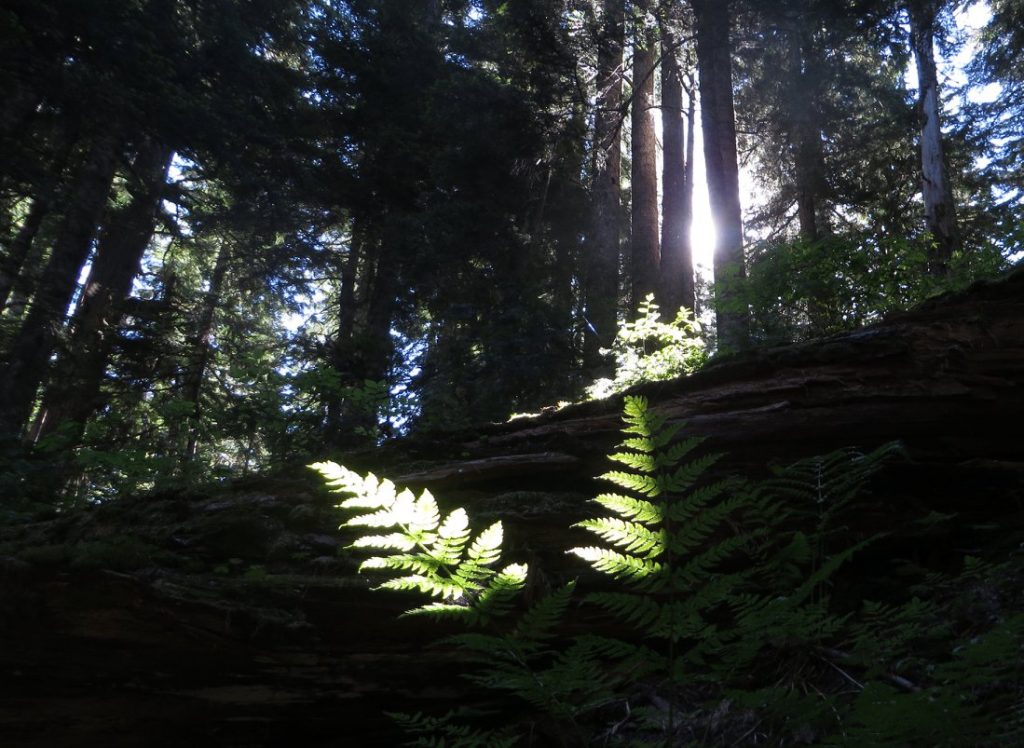
If you are hiking up into the high country from one of the valley bottoms, it will take a long time. For several miles and for an elevation gain of four thousand feet, you will see a lot of tree trunks. At first, you’ll be in the lowland forest of the western hemlock, the western red cedar, and the Douglas fir. It’s a lush forest, filled with mossy nurse logs, and the dense understory of salmonberry, red huckleberry, thimbleberry, devil’s club, salal, and various other shrubs.
After you’ve gained about 1000 feet (depending on your trailhead elevation), you will notice a change in the trees; you’ve entered the silver fir zone. You’ll be in this domain for a long time, and for a lot of switchbacks. Gradually as you ascend, mountain hemlocks will appear, and after gaining about 1500 feet, they will predominate. It will remain so until timberline.
At the lower end of its range mountain hemlock is a large tree, though not as large as its sibling, the western hemlock. The largest known mountain hemlocks in Washington approach 200 feet and are about 6 feet in diameter. (This is big, but not nearly as big as the lowland and coastal behemoths of the aforementioned species, some of which can reach 300 feet and be nearly 20 feet in diameter.) A typical large mountain hemlock might be 100 feet tall with a trunk a couple feet wide. Like the western hemlock, it is a tall, straight tree with a cylindrical form.
In the mountain hemlock zone, the forest is somber and dark. There isn’t as much of much of an understory as in the lower forest (although there are delicious huckleberries!). Brief and occasional glimpses of the snowy peaks above will tantalize you, through the thick trunks and heavy boughs of the hemlocks. Ever so gradually as you ascend, the hemlocks get smaller, but it’s only noticeable over miles and hours.
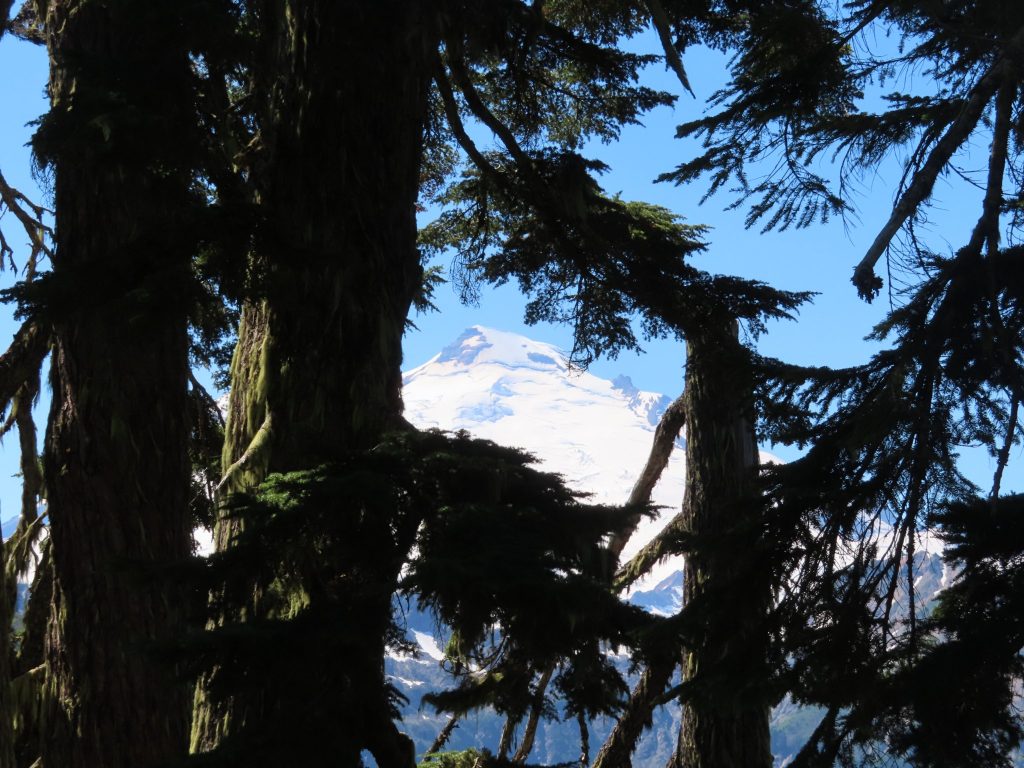
Now and then you may emerge from the forest into an avalanche path, a brief and chaotic strip of sudden sunlight, Sitka alder, downed trees and debris. Kind of a battle zone. Tongues of snow will last well into late summer. As much as any tree, mountain hemlock bears the brunt of natural violence. Avalanches routinely rip through timber, leaving behind a tapestry of bright and dark green stripes. It’s common to see large trunks snapped in two, like toothpicks. But this destruction notwithstanding, Tsuga mertensia has made its peace with snow.
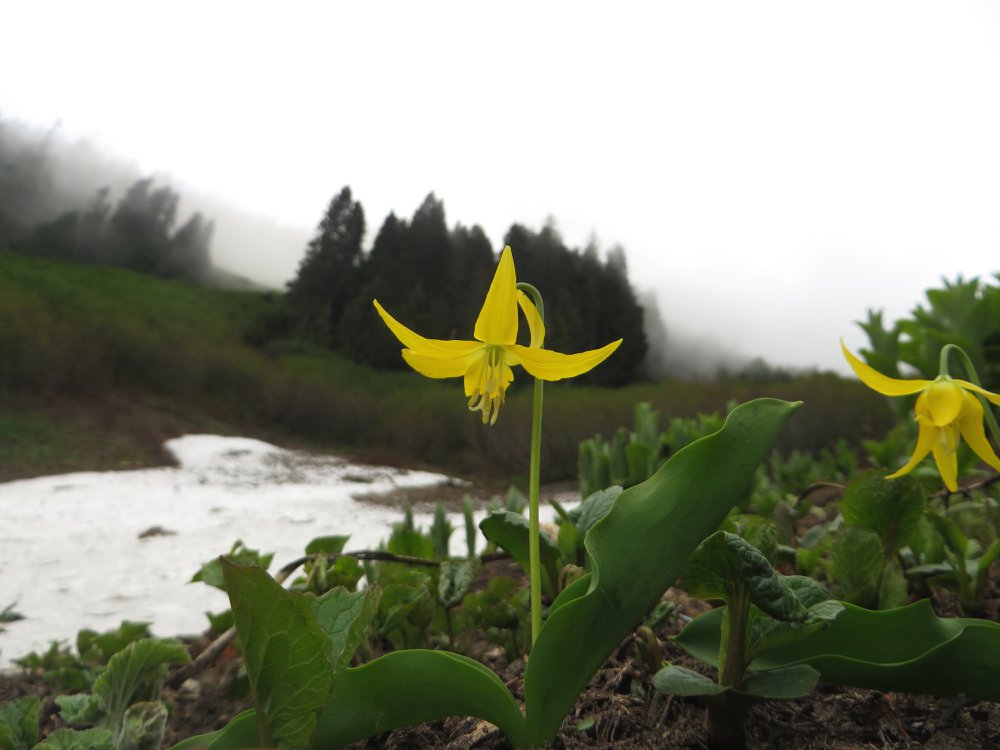
At the upper extent of its range, as it approaches timberline, the mountain hemlock can appear to be a whole different character. The higher you go, the smaller the trees become, both in terms of height and girth. Whereas they are tall and cylindrical at lower elevation, trees in the high country, burdened as they are with deeper loads of snow, can be beautifully misshapen. It is a creature defined by its relationship with snow.
Their crowns may be truncated or their boughs widely splayed. Their trunks may be J-rooted or bent. Without the benefit of a human pruner, these trees in the subalpine zone can become a piece of bonsai art. And like other trees that live at timberline, mountain hemlock can take on a gnarled, stunted form (known as krummholz) where it hunkers down in deference to fierce weather.
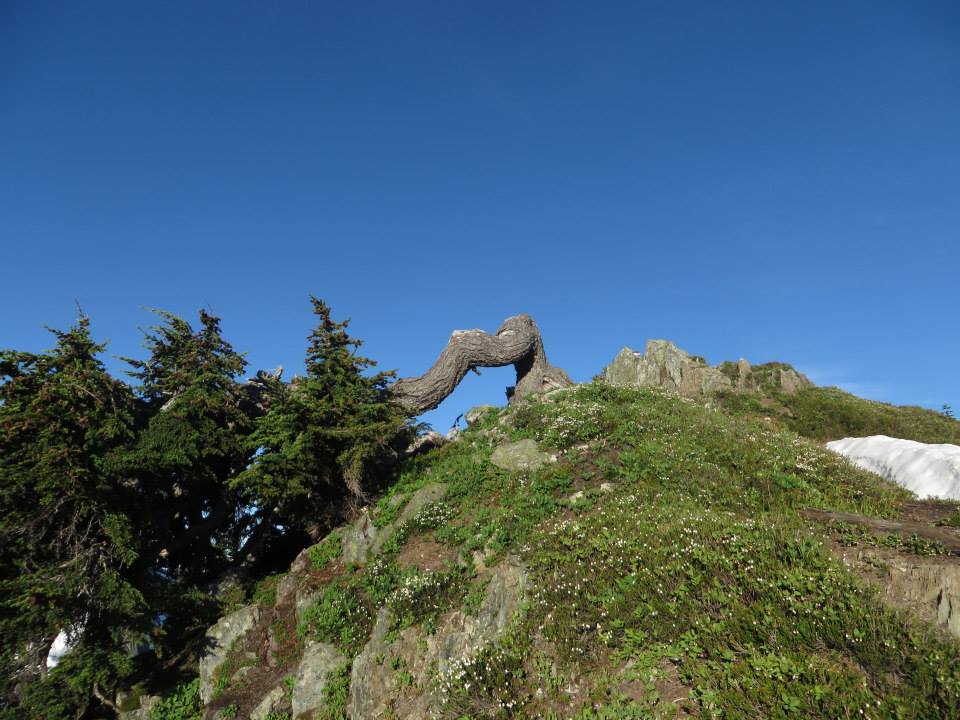
In the upper drainages of the Nooksack, the Baker, and the North Fork of the Skykomish, mountains of startling vertical relief form pockets that catch the prevailing southwesterly winds. These topographical catcher’s mitts bear the full force of the atmospheric rivers that hit the Cascade range. As a result, these watersheds are among the wettest places in North America.
Annual precipitation in these places can easily exceed 140 inches. Most of it comes in the winter. At the Mt. Baker ski area, annual snowfall averages around 600 inches and in many winters exceeds 800 inches. In the winter of 1998–99, the ski area recorded 1140 inches of snow — a world record. These are conditions in which the mountain hemlock thrives.
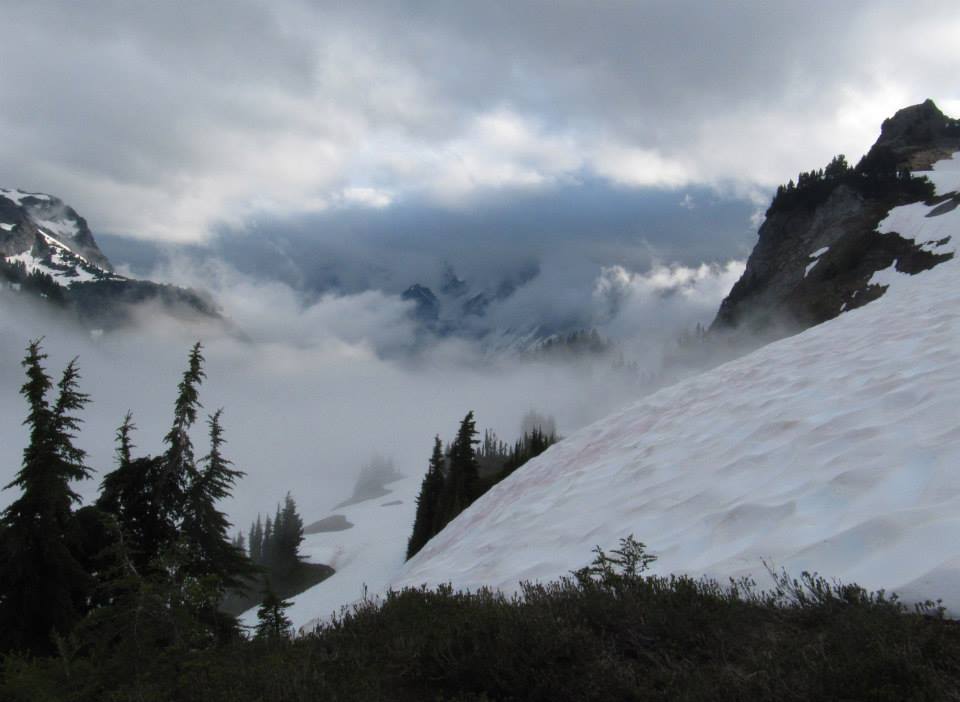
In one quite distinctive way, Tsuga mertensia demonstrates how it has evolved to succeed in such a snowy place. A very high sugary sap content imparts unusual flexibility in the trunk of the tree. This renders them extremely ‘bendy,’ so that they can be held down all the way to the ground by heavy snow loads, and then spring back up when the snow melts. BOING!!! Backcountry travelers are familiar with these ‘catapults,’ and are careful to walk around them rather than straddle them.
The Cascades are so effective at wringing moisture out of the atmosphere that the country on the leeward side, the eastern slope, is a spacious dryland forest of ponderosa pine. Not far beyond that, it is essentially a treeless grassland, thick with ticks and rattlesnakes (but not without its charms). But on the western slope where the mountain hemlock lives, the situation is steep, wet, and green. Cross-country travel is diabolically difficult. The North Cascades are a stand-offish range, not offering their treasures easily. But the treasures are sublime.
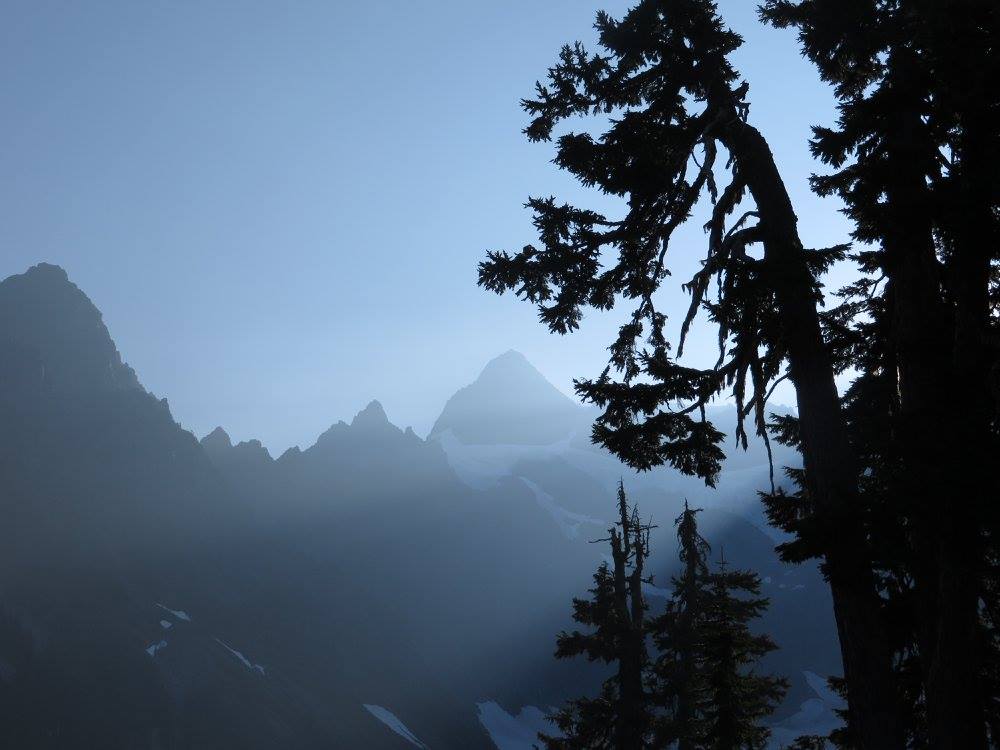
I’ve been speaking in a somewhat inexact way about ‘zones’ of vegetation. The concept is familiar to anyone who has driven a highway that goes from a low place to a high place. In each zone, there are not only characteristic trees, but shrubs, berries, flowers, fungi, birds, mammals, and all manner of living things. As elevation is gained, the species change, and so do the patterns of growth, of size, of density and spacial arrangement.
For many human travelers, the zone that is most sublime is what is known as the subalpine. The word ‘subalpine’ simply means below the alpine, which is accurate enough but not very poetic. What it is: slopes of butter-yellow avalanche lilies, timbered knolls, waterfalls, boulder gardens threaded by chattering streams, and glorious cirques jeweled with lakes that mirror snowcapped peaks.
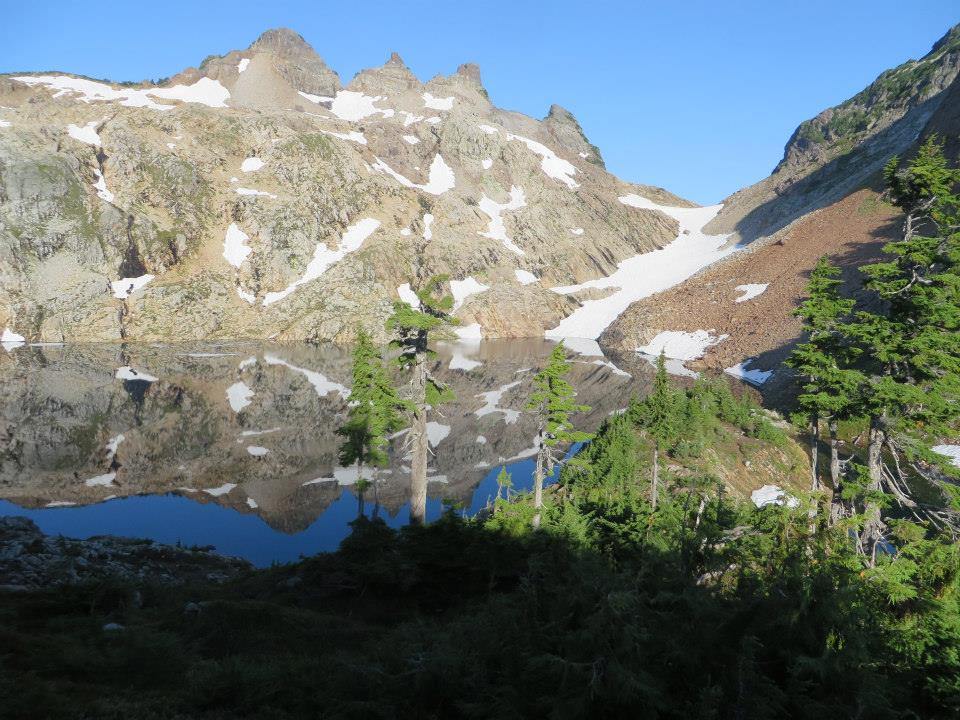
It’s where you camp the night before you attempt one of those high peaks, and wake up to a frosted world. Frozen or flowing, water infuses the landscape; it is in tiny pools, rivulets that gather into streams that tumble and plunge toward the rivers down below. It’s in dewdrops that bead the leaves of every flower and bush.
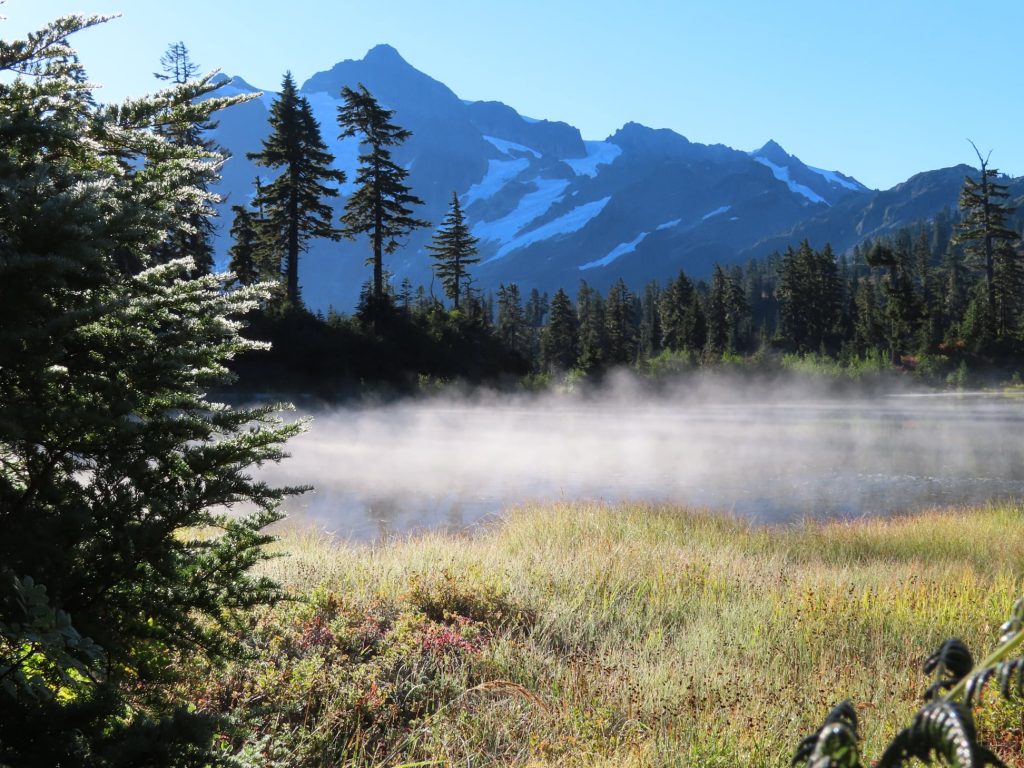
From high summer to the first snows of October, it’s a place of extravagant life. A lot of living is packed into a few short months. A whole lot of procreating. A lot of interspecies drama. A lot of color. The wildflowers waste no time, and neither do the bumblebees, butterflies, and birds. Tiny pollinated urns turn into plump berries on scarlet bushes. Ptarmigan chicks scuttle about in the heather, and marmots hoot at intruders.
Many modest summits top out in the subalpine, offering views that rival those from any hard-gained alpine peak. Glorious undulating ridges offer miles of delightful scrambling, alternating between rocky outcrops, meadows, and dense thickets of scrappy, dwarfish trees. Sibley Ridge and Trapper Peak are two of my favorite destinations in the subalpine.
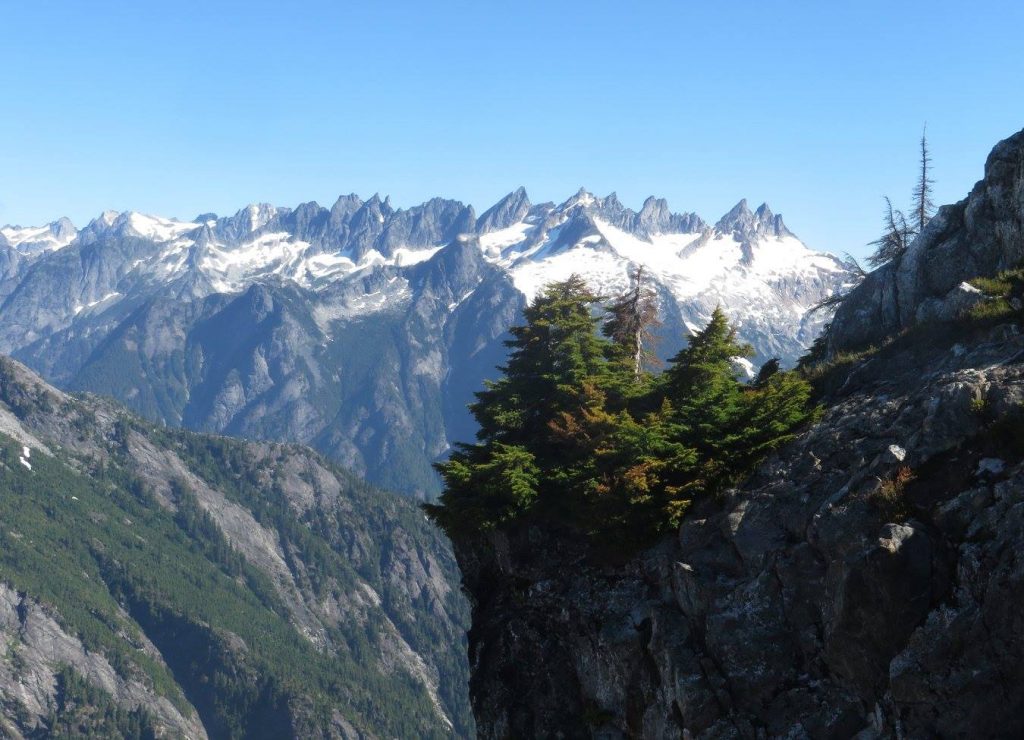
At a lower elevation Tsuga mertensia thickly carpets the slopes, but in the subalpine it is sparser, more widely scattered. It lives in clusters that are most often situated on small rises or ridges. In other words — atolls. The trees do not populate bowls or depressions; they are staking out the high ground. Why?
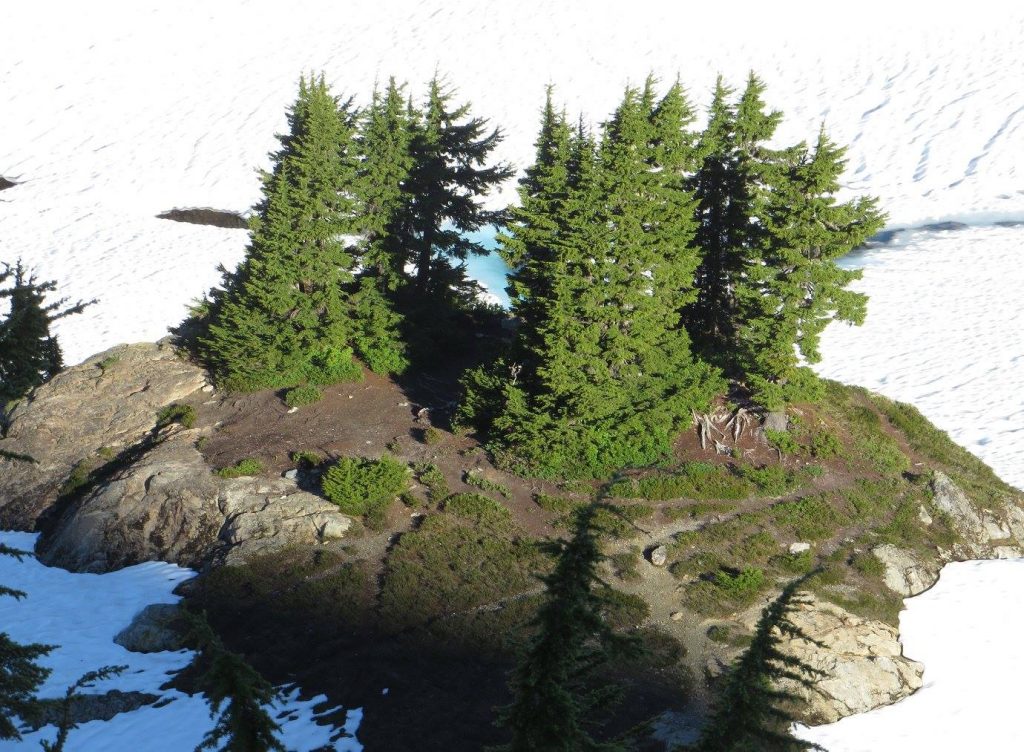
Because that is where the snowpack is thinnest, which means that is where the growing season is the longest. It’s where young trees are safe from avalanches that sweep away or bury everything in their path, and it’s where tiny saplings feel the warmth of the June sun, long before the surrounding meadow is free from its heavy blanket of snow.
Despite how these outcrops and promontories are exposed to the full force of winter gales, it is precisely here that young mountain hemlocks find a hospitable place to get started in life. Especially if they can grow close in the orbit of an old survivor. The typical pattern is that there are, within a small atoll, one or two trees that are significantly older and larger than the rest.
In any atoll, one intrepid tree had to start things off. If the winged seed from a Tsuga mertensia cone was lucky enough to land on a good spot, it might make it. The first years would have been the hardest. Then there comes a time when this persistent pioneer tree becomes shelter for another. And so the atoll begins.
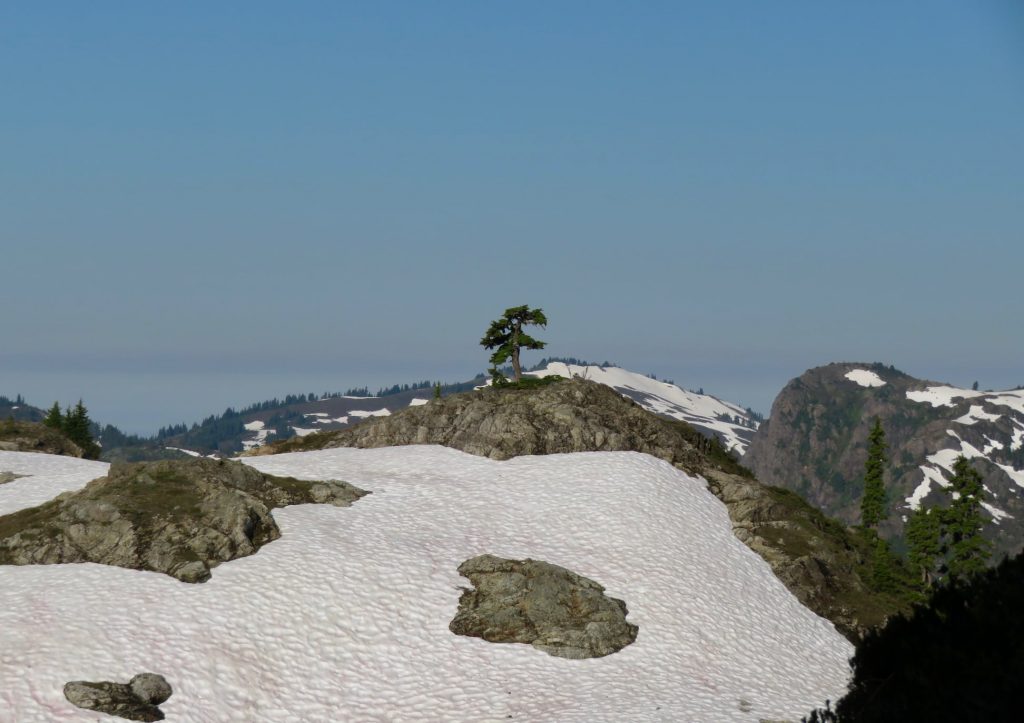
Once a single tree is tall enough to poke out above the winter snowpack, it creates conditions favorable for the growth of new trees. The dark foliage of the tree speeds melting around its base, allowing for patches of warm, bare ground while an adjacent meadow is still blanketed in snow.
There is a correlation between snowpack and the establishment and expansion of atolls. In an extended period of drier and warmer winters, atolls are likely to expand and new ones will become established. When there is a longer growing season, trees stake out new ground. These trailblazers will survive and grow tall enough to establish a safe harbor for subsequent seedlings. On the other hand, a string of heavy snow winters will inhibit the expansion of atolls and prevent new ones from getting started.
The way these mountain hemlock atolls are dispersed across the landscape is very satisfying to the eye. It is as aesthetic as any designed garden. One way to think of it is that this particular instance of beauty is shaped by hardship. Or, to be more precise, it is shaped by Tsuga mertensia’s response to hardship.
In our thinking about evolution and adaptation, we often recognize the importance of competition — especially in situations where life is particularly precarious. Do we appreciate, also, the importance of cooperation? Do we understand the ways in which one tree grows in the grace of another?

